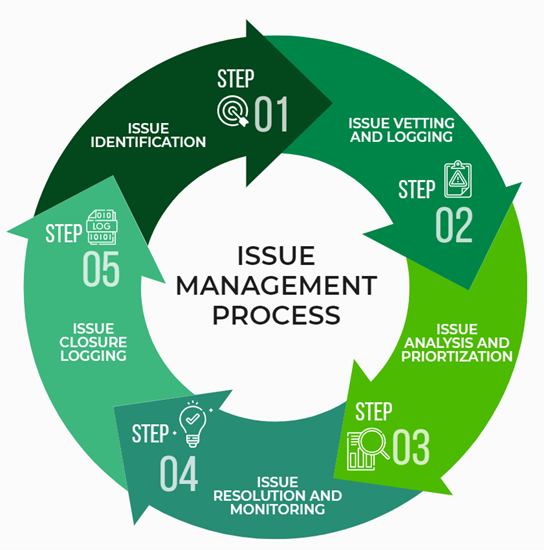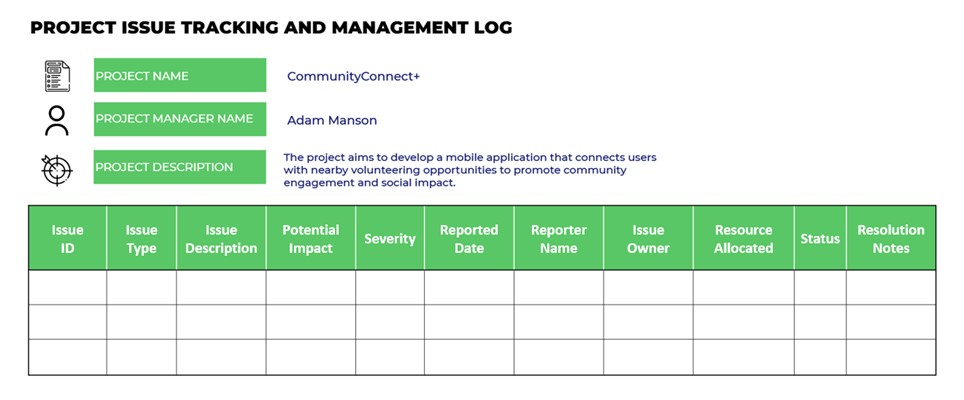
Unforeseen obstacles, tight deadlines, and lurking resource constraints are inherent risks in every project. How confident are you in your team's ability to overcome these hurdles and ensure smooth progress? Successful project issue management requires more than just a well-crafted plan and a capable team. It is about foreseeing the challenges that lie ahead and having a sturdy system in place to tackle them head-on.
Issue management—the north star of project success. It is the process that empowers project teams to identify, address, and resolve obstacles efficiently, steering the project toward success. So, ask yourself: Does your project have a robust issue management process? In this article, we will explore what issue management is, the issue management process, the benefits of issue management, and issue management examples.
What Is Issue Management?
Every project faces challenges. But how well your team handles those challenges can make all the difference between success and failure. That is where issue management comes in.
Issue management is the process of identifying, tracking, and resolving issues that arise during a project. The goal of issue management is to minimize the impact of issues on the project's success. A well-designed issue management process can help project managers identify potential issues before they become major problems, prioritize issues based on their impact on the project, and track the progress of issue resolution.

Issue Management Process
The issue management process is cyclical and involves several steps. The following are the steps involved in the issue management process:
- Issue Identification - Unearth potential issues early through project status meetings, stakeholder feedback, and more, mitigating their impact on the project.
- Issue Logging - Document each issue in the issue log, detailing its description, project impact, and priority. Regular updates ensure an accurate status overview.
- Issue Prioritization - Categorize issues by their impact, addressing high-priority concerns first, followed by medium- and low-priority ones.
- Issue Resolution - Tackle issues head-on with tailored resolutions, ranging from simple fixes to complex solutions.
- Issue Closure - Document resolved issues in the log, along with valuable insights for continuous improvement.
The issue management process empowers teams to navigate projects with confidence, ensuring smoother sailing toward success.

The Benefits of Issue Management
Having a strong issue management process in place can provide several benefits to a project, including:
- Improved Project Success - A well-designed issue management process can help minimize the impact of issues on the project's success.
- Increased Stakeholder Confidence - When stakeholders see that issues are being identified and resolved quickly, they will have more confidence in the project's ability to succeed.
- Better Communication - Issue management requires regular communication between project team members, which can improve overall communication on the project.
- Improved Risk Management - By identifying and resolving issues early, project managers can minimize the risk of issues becoming major problems.
Issue Management Examples
Here are some examples of issues that could arise during a project:
- Resource Constraints - A lack of resources, such as staff or funding, could impact the project's ability to meet its goals.
- Scope Creep - Changes to the project's scope could impact the project's timeline, budget, and overall success.
- Communication Breakdowns - Poor communication between project team members could lead to misunderstandings and delays.
- Technical Issues - Technical issues, such as software bugs or hardware failures, could impact the project's ability to meet its goals.
- Vendor Issues - Issues with vendors, such as delays in delivery or quality issues, could impact the project's ability to meet its goals.

Information to Include in an Issue Log

When creating an issue log, consider including the following information:
- Issue ID -The name or number given to the issue to identify it.
- Issue Type - Define categories for the types of issues you are likely to encounter. This helps track them and assign the right people to resolve them.
- Reported by - Record, who discovered the issue.
- Reported Date and Time- Indicate when the issue was identified.
- Description: Provide details about what happened and the potential impact. If the issue remains unresolved, identify which parts of the project will be affected.
- Priority/Severity - Assign a priority rating to the issue, such as high, medium, or low, based on its impact on the project's success.
- Assigned to - Determine who is responsible for resolving and/or tracking the issue and ensuring its resolution according to priority.
- Resource - List the resources engaged to resolve the issue.
- Third-Party - These are issues related to vendors, suppliers, or any outside third party.
- Target Resolution Date - Set a deadline for resolving the issue.
- Status - Track the progress of issue resolution using labels such as open, investigating, implementing, escalating, or resolved.
- Action/Resolution Description - Describe the actions taken to find and implement a resolution, including the dates of each action.
- Final Resolution - Provide a brief description of how the issue was addressed.

Source: Techno-PM
Issue Management Framework: Supplementing Your Issue Log
An issue management framework is a process for dealing with issues once they have been identified and logged. It helps the project team understand what to do with issues and how to resolve them quickly and efficiently. Developing an issue management framework involves answering several questions, such as:
- How will you assign responsibility for resolving the issue?
- How will you know when to escalate an issue to management or the steering committee?
- Which criteria will determine an issue's priority status?
- Who will set the target resolution date?
- How will issues be communicated within the team?
- How will you identify different issues if several occur during one project?
- If change orders are needed, how will those be handled?
- When the resolution affects the budget or schedule, what will the update process be, and who will be responsible?
By developing an issue management framework, you provide a structure for making decisions when issues arise. This proactive approach helps minimize the impact of issues on the project and ensures that projects stay on track to meet their objectives.
Conclusion
Issues are inevitable in any project, but having a strong issue management process in place can help minimize their impact on the project's success. By following the issue management process and implementing best practices, project managers can identify, track, and resolve issues in a timely and effective manner. This can lead to improved project success, increased stakeholder confidence, better communication, and improved risk management.
How TrueProject Can Help with Issue Management
TrueProject is an optimal project management solution that can greatly enhance the issue management process. With its predictive intelligence and robust features, TrueProject enables teams to identify, track, and resolve issues efficiently. By following the cyclical issue management process, you can unearth potential issues early, document them in the issue management log, prioritize them based on their impact, and tackle them head-on with tailored resolutions. TrueProject also provides a comprehensive framework for dealing with issues once they have been identified and logged, ensuring quick and efficient resolution. By implementing TrueProject as your project management software, teams can minimize the impact of issues on project success, increase stakeholder confidence, improve communication, and enhance risk management. With TrueProject, projects can stay on track and achieve their objectives with ease.
More information about TrueProject on trueprojectinsight.com

About the Author
Dale Malcolm is the Director of Trueproject Customer Success with over 30 years of experience spanning software development, consulting, and business process re-engineering across multiple industries and countries. He has excelled in roles ranging from lead architect for data collection systems to database architect for telecom software and has led various teams in implementing cost-effective and efficient IT solutions, including ERP and Enterprise Architecture practices.
Endnotes
- Pradip, P. (2023). "What is an Issue Log?" Simplilearn: June 23, 2023. https://www.simplilearn.com/issue-log-concepts-article
- Mind Tools Content Team. "Project Issue Management". Mind Tools: (n.d.). https://www.mindtools.com/a7dj6xv/project-issue-management
- The LinkedIn Team. "What are the benefits of having clear and consistent issue management process?" LinkedIn: (n.d). https://www.linkedin.com/advice/1/what-benefits-having-clear-consistent-issue-management
- Auditboard Team. "Issue Management: Seven Tips for a Well-Rounded Program." Auditboard: October 16, 2019. https://www.auditboard.com/blog/well-rounded-issues-management-program/





